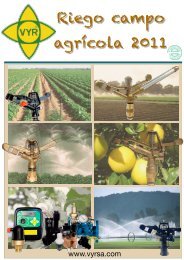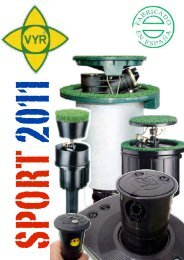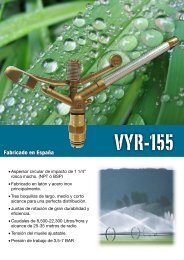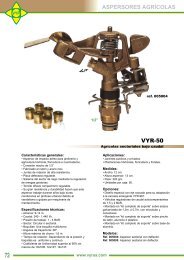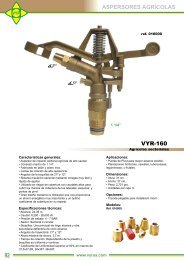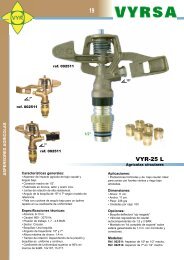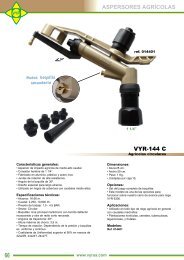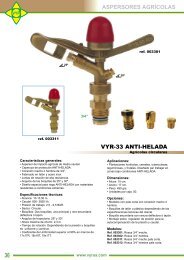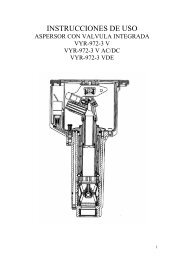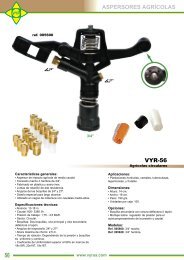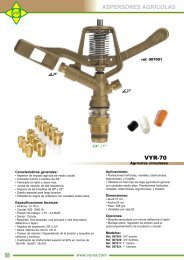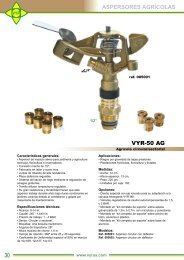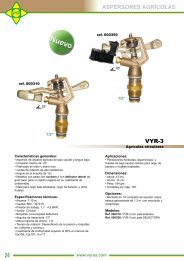Recomendacion de marcos VYR.pdf - Vyrsa
Recomendacion de marcos VYR.pdf - Vyrsa
Recomendacion de marcos VYR.pdf - Vyrsa
Create successful ePaper yourself
Turn your PDF publications into a flip-book with our unique Google optimized e-Paper software.
RECOMENDACIONES TÉCNICAS EN DISEÑOS DE RIEGO<br />
DATOS QUE LE<br />
AYUDARÁN A<br />
DIMENSIONAR Y CALCULAR<br />
LOS MARCOS DE RIEGO EN<br />
SU SISTEMA DE<br />
ASPERSIÓN<br />
Edición especial Cobertura Enterrada<br />
AIMCRA 2010
100% COBERTURA<br />
ENTERRADA:<br />
Dimensionamiento y obra civil.<br />
Una <strong>de</strong> las preguntas más<br />
frecuentes en nuestros clientes es<br />
la <strong>de</strong> cual es el marco <strong>de</strong> riego<br />
recomendado <strong>de</strong>pendiendo <strong>de</strong>l<br />
mo<strong>de</strong>lo <strong>de</strong> aspersor utilizado,<br />
boquillas, caudal y presión <strong>de</strong><br />
trabajo.<br />
En este documento intentaremos<br />
respon<strong>de</strong>r esta cuestión<br />
aportando datos <strong>de</strong> los mo<strong>de</strong>los<br />
<strong>de</strong> aspersor y boquillas más<br />
comunes y los <strong>marcos</strong> <strong>de</strong> riego<br />
que nos aportan un mayor grado<br />
en su coeficiente <strong>de</strong> uniformidad.<br />
Cálculo hidráulico y obtimización <strong>de</strong>l<br />
diseño. Perdidas <strong>de</strong> carga, golpes<br />
<strong>de</strong> ariete y turbulencias.<br />
Espaciamiento entre laterales y<br />
cabezales. “Solapaje”.<br />
Elección <strong>de</strong> un aspersor y boquillas.<br />
Simulación con WinSpace para CU.<br />
Dirección <strong>de</strong>l viento predominante.<br />
Costes: Energéticos, agua, mano <strong>de</strong><br />
obra, mantenimiento.<br />
Automatización y control.<br />
Ensayos experimentales aplicados:<br />
evotranspiración y coficientes <strong>de</strong><br />
cultivo.
Técnica <strong>de</strong>l sistema:<br />
El diseño y dimensionamiento.<br />
Son el diseño, estructura (tipo <strong>de</strong> suelo, drenaje y tipo <strong>de</strong> cultivo), y<br />
condiciones metereológicas las que nos proporcionan toda la<br />
información necesaria a la hora <strong>de</strong> realizar un estudio para la instalación<br />
<strong>de</strong> un sistema <strong>de</strong> riego. Para ello es necesario acometer un cálculo<br />
hidráulico (siempre <strong>de</strong>s<strong>de</strong> atrás hacia a<strong>de</strong>lante/ <strong>de</strong>s<strong>de</strong> los aspersores<br />
hasta la bomba): dimensionamiento <strong>de</strong> tuberias, cálculo <strong>de</strong> perdidas <strong>de</strong><br />
carga, espaciamiento entre aspersores y laterales, etc.<br />
Los aspersores y boquillas<br />
Los aspersores y sus boquillas son los encargados <strong>de</strong> que la distribución<br />
<strong>de</strong>l agua sobre el suelo sea <strong>de</strong> forma uniforme . En <strong>VYR</strong> le ofrecemos<br />
una amplia gama <strong>de</strong> aspersores y boquillas que harán que sus campos<br />
cuenten con la última tecnología en aspersión.<br />
Las válvulas, conexiones y tuberías<br />
Las válvulas <strong>VYR</strong> ofrecen todas las necesida<strong>de</strong>s para la gestión <strong>de</strong>l agua<br />
en la agricultura. Para el control <strong>de</strong>l flujo hidráulico contamos con<br />
reguladores <strong>de</strong> caudal y presión, solenoi<strong>de</strong>s, <strong>de</strong>codificadores, ó válvulas<br />
<strong>de</strong> ventosa.<br />
La red <strong>de</strong> tuberías y conexiones han <strong>de</strong> estar dimensionadan para que<br />
las perdidas <strong>de</strong> carga se minimicen y que a la vez nos ofrezca seguridad<br />
y durabilidad.<br />
La estación <strong>de</strong> bombeo<br />
La estación <strong>de</strong> bombeo a <strong>de</strong>manda es el corazón <strong>de</strong>l sistema. Los<br />
equipos profesionales <strong>de</strong> bombeo <strong>VYR</strong> cuentan con un sistema <strong>de</strong><br />
reparto inteligente, compensación <strong>de</strong> caudales y sistema <strong>de</strong> seguridad<br />
con variador <strong>de</strong> frecuencia.<br />
Automatización y control<br />
Mediante la automatización <strong>de</strong>l sistema <strong>de</strong> riego nos ahorraremos<br />
mucho tiempo y dinero, y al mismo tiempo nos aseguraremos un aporte<br />
<strong>de</strong> agua correcto para nuestros cultivos. Las últimas tecnologías han<br />
sido aplicadas para minimizar costes y maximizar el ahorro energético y<br />
<strong>de</strong> agua.
RECOMENDACIONES<br />
<strong>VYR</strong>-16<br />
<strong>VYR</strong>-25<br />
<strong>VYR</strong>-35<br />
<strong>VYR</strong>-36<br />
<strong>VYR</strong>-60<br />
<strong>VYR</strong>-66<br />
<strong>VYR</strong>-70<br />
<strong>VYR</strong>-56<br />
<strong>VYR</strong>-70V<br />
<strong>VYR</strong>-56<br />
<strong>VYR</strong>-155<br />
<strong>VYR</strong>-144<br />
<strong>VYR</strong>-150<br />
<strong>VYR</strong>-160<br />
<strong>VYR</strong>-100<br />
Conexión 1/2” 3/4” 3/4” 3/4” 1” 1 1/4” 1 1/4” 2”<br />
Caudal medio recomendado 900 1800 1800 2200 3600 4500 4500 5500<br />
Presión media recomendada 1,5 3,5 3,5 4 4 5 5 5<br />
Alcance 10 14 14 15 19 25 25 32<br />
Marcos recomendados T 12X12 T 18x18 T 18X18 T 18X21 T 21X21 T 28X28 T 28X28 T 32X32<br />
CU medios a <strong>marcos</strong><br />
recomendados<br />
Precipitación media<br />
recomendada<br />
> 90 % > 90 % > 90 % > 90 % > 86 % > 87 % > 87 % > 85 %<br />
1,8 3,8 3,8 4,6 5,7 7 7 8<br />
Elección <strong>de</strong> un aspersor y sus boquillas:<br />
1. La pluviometría <strong>de</strong>l aspersor <strong>de</strong>be ser menor que la permeabilidad máxima <strong>de</strong>l suelo.<br />
2. La pluviometría se obtiene dividiendo el caudal <strong>de</strong>l aspersor, expresado en litros / hora, entre la superficie <strong>de</strong>l marco consi<strong>de</strong>rado, en<br />
metros cuadrados.<br />
Ejemplo: si tenemos un aspersor que a 3 kg/cm2 <strong>de</strong> presión <strong>de</strong>scarga un caudal <strong>de</strong> 1870 litros / hora, y los aspersores están instalados en<br />
marco 18 x 18 metros (324 metros3), la pluviometría sería:<br />
1870 (l/h) / 324 m3 = 5.7 milímetros / hora (mm/h).<br />
3. Los sistemas <strong>de</strong> riego por aspersión <strong>de</strong>ben tener pluviometrías comprendidas entre 5 y 7 mm/h.<br />
4. Las pequeñas pluviometrías son recomendadas para suelos pesados (arcillosos) o terrenos con pendiente.<br />
5. La cantidad máxima <strong>de</strong> agua que un suelo es capaz <strong>de</strong> absorber en una hora según su textura se indica en el siguiente cuadro:<br />
Textura <strong>de</strong>l suelo Permeabilidad máxima (mm/h):<br />
Arenoso....................... 19<br />
Arenoso - franco.......... 12.7<br />
Franco arenoso........... 10.9<br />
Francos....................... 8.9<br />
Franco-limoso............. 7.6<br />
Franco-arcilloso.......... 6.4<br />
Arcillo-limosos............ 5<br />
Arcilloso....................... 3.8<br />
6. Los aspersores <strong>de</strong>ben aportar caudal suficiente al cultivo según número <strong>de</strong> riegos y duración <strong>de</strong> los mismos.<br />
7. La distancia recomendada entre aspersores calculada a partir <strong>de</strong>l diámetro regado.<br />
8. Un aspersor no distribuye el agua <strong>de</strong> manera totalmente uniforme, recibiendo más agua la zona más próxima al aspersor y menos<br />
agua a medida que nos alejamos <strong>de</strong> aquel. De ahí que, cuando se riega en bloque, es necesario solapar una parte <strong>de</strong> las áreas<br />
regadas para lograr una mayor uniformidad <strong>de</strong> reparto.<br />
Entre aspersores 50% 45% 30%<br />
Entre ramales 65% 60% 50%
<strong>Recomendacion</strong>es <strong>de</strong> diseño:<br />
9. Manejo <strong>de</strong>l riego por aspersión<br />
¿Qué es la Tasa <strong>de</strong> Precipitación?<br />
Una tormenta que cubre un área con unos 20 l/m2 <strong>de</strong> agua en una hora, tiene una “tasa <strong>de</strong> precipitación” <strong>de</strong> unos 20 l/m2 <strong>de</strong> agua<br />
en una hora. Igualmente, la tasa <strong>de</strong> precipitación es la “velocidad” a la cual un aspersor o sistema <strong>de</strong> riego aplica el agua.<br />
Si alguien dice que fue atrapado en una tormenta que <strong>de</strong>jó unos 20 l/m2 (1 pulgada) <strong>de</strong> agua en una hora, usted tendrá alguna i<strong>de</strong>a<br />
<strong>de</strong> lo “fuerte” que fue la tormenta.<br />
¿Todas las tasas <strong>de</strong> precipitación son iguales?<br />
¡Absolutamente no! Existen diferentes niveles y tasas <strong>de</strong> precipitación según los tipos <strong>de</strong> boquillas y <strong>de</strong> replanteo <strong>de</strong> los aspersores,<br />
estando en disposición cuadrangular, triangular o en línea.<br />
Las tasas varian normalmente entre:<br />
• BAJO: 6-13 mm/h • MEDIO: 13-25 mm/h • ALTO: 25 mm/h y más alto<br />
Calculando Tasas <strong>de</strong> Precipitación<br />
Dependiendo <strong>de</strong> la construcción <strong>de</strong>l sistema <strong>de</strong> riego, la tasa <strong>de</strong> precipitación podrá ser calculada por cualquiera <strong>de</strong> los métodos <strong>de</strong><br />
“esparcimiento <strong>de</strong> los aspersores”, ó el <strong>de</strong> “área total”.<br />
Método <strong>de</strong> Esparcimiento <strong>de</strong> los Aspersores. La tasa <strong>de</strong> precipitación <strong>de</strong>berá ser calculada en cada zona individualmente. Si todos<br />
los aspersores tienen el mismo espaciamiento, caudal y arco <strong>de</strong> cobertura, use una <strong>de</strong> las siguientes fórmulas:
MARCOS RECOMENDADOS PARA ASPERSORES DE CAUDAL MEDIO<br />
Presión<br />
3,5 BAR 3,5 BAR 4 BAR 4,5 BAR 4,5 BAR<br />
Marcos<br />
Boq<br />
mm<br />
<strong>VYR</strong>-35<br />
Q<br />
l/h<br />
D<br />
m<br />
CU<br />
% Boq<br />
<strong>VYR</strong>-60<br />
Q<br />
l/h<br />
D<br />
m<br />
CU<br />
%<br />
<strong>VYR</strong>-70<br />
Boq Q<br />
l/h<br />
D<br />
m<br />
<strong>VYR</strong>-70V<br />
CU Boq Q D<br />
% l/h m<br />
CU<br />
%<br />
<strong>VYR</strong>-65<br />
Boq Q<br />
l/h<br />
D<br />
m<br />
CU<br />
%<br />
14x14 Triang. 4,4 x 2,4 1800 15 83 --- --- --- --- --- --- --- --- --- --- --- --- --- --- --- ---<br />
14x14 Rectang. 4,4 x 2,4 1800 15 84 --- --- --- --- --- --- --- --- --- --- --- --- --- --- --- ---<br />
15X18 Triang. 4,4 x 2,4 1800 15 92 4,4 x 2,4 1800 15,5 90 --- --- --- --- --- --- --- --- --- --- --- ---<br />
15X18 Rectang 4,4 x 2,4 1800 15 93 4,4 x 2,4 1800 15,5 91 --- --- --- --- --- --- --- --- --- --- --- ---<br />
18x18 Triang. 4,4 x 2,4 1800 15 91 4,4 x 2,4 1800 15,5 92 4,8X3,2 2600 16,5 91 --- --- --- --- --- --- --- ---<br />
18x18 Rectang 4,4 x 2,4 1800 15 88 4,4 x 2,4 1800 15,5 89 4,8X3,2 2600 16,5 92 --- --- --- --- --- --- --- ---<br />
20x20 Triang. 4,8x 2,4 2150 16 89 4,8x 2,4 2150 16 90 4,8X3,2 2600 16,5 90 6,4 X 4,8 5150 21,5 89 --- --- --- ---<br />
18X21 Rectang 4,8 x 2,4 2150 16 91 4,8 x 2,4 2150 16 89 4,8X3,2 2600 16,5 89 6,4 X 4,8 5150 21,5 90 --- --- --- ---<br />
22x22 Triang. 4,8 x 2,4 2150 16 86 4,8 x 2,4 2150 16 88 5,2X3,2 2900 17 89 6,4 X 4,8 5150 21,5 86 6,4 x 3,2 4200 19 88<br />
22x22 Rectang 4,8 x 2,4 2150 16 84 4,8 x 2,4 2150 16 85 5,2X3,2 2900 17 86 6,4 X 4,8 5150 21,5 89 6,4 x 3,2 4200 19 89<br />
24x24 Triang. 5,2X3,2 2900 17 84 7,2X4,8 5950 22,5 88 6,4X3,2 4200 19 90<br />
24x24 Rectang 5,2X3,2 2900 17 81 7,2X4,8 5950 22,5 89 6,4X3,2 4200 19 92<br />
26x26 Triang. 7,2X4,8 5950 22,5 84 7,2X3,2 5000 20 84<br />
26x26 Rectang 7,2X4,8 5950 22,5 86 7,2X3,2 5000 20 88<br />
Presión<br />
3,5 BAR 3,5 BAR 3,5 BAR 4 BAR 4 BAR<br />
<strong>VYR</strong>-36<br />
<strong>VYR</strong>-66<br />
<strong>VYR</strong>-56<br />
<strong>VYR</strong>-86<br />
<strong>VYR</strong>-166<br />
Marcos<br />
Boq<br />
mm<br />
Q<br />
l/h<br />
D<br />
m<br />
CU<br />
%<br />
Boq Q<br />
l/h<br />
D<br />
m<br />
CU<br />
%<br />
Boq Q<br />
l/h<br />
D<br />
m<br />
CU Boq Q D<br />
% l/h m<br />
CU<br />
%<br />
Boq Q<br />
l/h<br />
D<br />
m<br />
CU<br />
%<br />
14x14 Triang. 4 x 2,4 1560 15 89 --- --- --- --- --- --- --- --- --- --- --- --- --- --- --- ---<br />
14x14 Rectang. 4 x 2,4 1560 15 86 --- --- --- --- --- --- --- --- --- --- --- --- --- --- --- ---<br />
15X18 Triang. 4 x 2,4 1560 15 92 4 x 2,4 1560 13,5 89 --- --- --- --- --- --- --- --- --- --- --- ---<br />
15X18 Rectang 4 x 2,4 1560 15 91 4 x 2,4 1560 13,5 85 --- --- --- --- --- --- --- --- --- --- --- ---<br />
18x18 Triang. 4 x 2,4 1560 15 90 4 x 2,4 1560 13,5 94 4 x 2,4 1670 15,15 90 --- --- --- --- --- --- --- ---<br />
18x18 Rectang 4 x 2,4 1560 15 89 4 x 2,4 1560 13,5 90 4 x 2,4 1670 15,5 92 --- --- --- --- --- --- --- ---<br />
20x20 Triang. 4,4 x 2,4 1800 16 87 4,4 x 2,4 1800 14 84 4 x 2,4 1670 15,5 89 6,4 X 4,8 5150 21,5 89 --- --- --- ---<br />
18X21 Rectang 4,4 x 2,4 1800 16 88 4,4 x 2,4 1800 14 86 4 x 2,4 1670 15,5 91 6,4 X 4,8 5150 21,5 90 --- --- --- ---<br />
22x22 Triang. 4,4 x 2,4 1800 16 82 4,4 x 2,4 1800 14 81 4,4 x 2,4 1920 16,5 88 6,4 X 4,8 5150 21,5 87 5,5 x 3,2 2900 18 90<br />
22x22 Rectang 4,4 x 2,4 1800 16 81 4,4 x 2,4 1800 14 80 4,4 x 2,4 1920 16,5 84 6,4 X 4,8 5150 21,5 90 5,5 x 3,2 2900 18 89<br />
24x24 Triang. 4,4 x 2,4 1920 16,5 80 7,2X4,8 5950 22,5 87 5,5 x 3,2 2900 18 86<br />
24x24 Rectang 4,4 x 2,4 1920 16,5 81 7,2X4,8 5950 22,5 89 5,5 x 3,2 2900 18 89<br />
26x26 Triang. 7,2X4,8 5950 22,5 82 6,3 x 2,1 3700 19 80<br />
26x26 Rectang 7,2X4,8 5950 22,5 85 6,3 x 2,1 3700 19 82<br />
NOTA: Estos resultados han sido obtenidos en test <strong>de</strong> laboratorio con velocidad <strong>de</strong> viento 0 Km/h.
COMPARATIVA DE EFICIENCIA E INVERSIÓN<br />
EFICIENCIA<br />
COBERTURA<br />
ENTERRADA<br />
PIVOT<br />
COBERTURA<br />
MOVIL<br />
CU 83-92 % 85-93 % 83-92 %<br />
UD ^80% ^80% ^80%<br />
Costes <strong>de</strong> riego según tipo <strong>de</strong> energía<br />
(inversión, mantenimiento, energía).<br />
ETc BAJA ALTA BAJA<br />
COSTE ENERGÉTICO MEDIO ANUAL DE BOMBEO EN RIEGO DURANTE UN<br />
PERIODO DE 10 AÑOS. “AGUA”<br />
PERFORACIÓN<br />
CANAL<br />
ALTURA MANOMÉTRICA DE 130 M. 2010<br />
ELÉCTRICO<br />
DIESEL<br />
ELÉCTRICO<br />
DIESEL<br />
RIEGO A LA DEMANDA<br />
Teniendo en cuenta la<br />
facturación real <strong>de</strong> horas punta<br />
y horas valle.<br />
PIVOT+ESQUINAS<br />
COBERTURA<br />
ENTERRADA<br />
PIVOT+ESQUINAS<br />
COBERTURA<br />
ENTERRADA<br />
PIVOT+ESQUINAS<br />
COBERTURA<br />
ENTERRADA<br />
PIVOT+ESQUINAS<br />
COBERTURA<br />
ENTERRADA<br />
PIVOT+ESQUINAS<br />
19 horas/dia<br />
COBERTURA<br />
ENTERRADA<br />
9 horas/dia<br />
2431<br />
1548<br />
Comparativa <strong>de</strong> coste anual en 10 años:<br />
Cobertura enterrada latón y Pivot con riego a <strong>de</strong>manda.<br />
Escorrentia BAJA MEDIA BAJA<br />
Servicio Técnico Autónomo Dependiente Autónomo<br />
Aprovechamiento <strong>de</strong>l<br />
terreno<br />
100% Esquinas (35%) 100%<br />
Riegos por avería PERDIDA PARCIAL PERDIDA TOTAL PERDIDA PARCIAL<br />
Perdidas <strong>de</strong> carga MENOR 20% MENOR 20% MENOR 20%<br />
Riego solapable /<br />
fertilización<br />
SI NO SI<br />
Costes inversión Altos Altos Bajos<br />
Costes mantenimiento Muy bajos Muy altos Altos<br />
ACEPTABLE<br />
NO ACEPTABLE<br />
NOTA: Estos son datos reales obtenidos <strong>de</strong> las medias <strong>de</strong><br />
estudios públicos. El COSTE TOTAL es el coste anual medio <strong>de</strong><br />
cada sistema teniendo en cuenta todos los parámetros<br />
contabilizables.<br />
RIEGO DE 12+3,3 HA<br />
COSTE ANUAL @ 10 AÑOS<br />
COBERTURA FIJA<br />
PIVOT BÁSICO 360º<br />
+ 4 ESQUINAS<br />
COSTE INVERSIÓN 10 AÑOS (4000x15,3 €) / 10 (3000x12 € +<br />
5000x3,3 €) / 10<br />
COSTE ENERGÉTICO 0 € + 4608 € +<br />
COSTE MANTENIMIENTO 150 €<br />
120 € REVISIÓN +<br />
(5400 € GRUPO /10)<br />
+<br />
900 € materiales<br />
COSTE AMORTIZACIÓN -- --<br />
COSTE DE OBRA CIVIL 3400 € /10 6500 € /10<br />
COSTE SEGURO 370 € 600 €<br />
COSTE TOTAL 6,980 € 12,158 €<br />
NOTA: Estos son datos reales obtenidos <strong>de</strong> las medias <strong>de</strong> estudios públicos. El COSTE TOTAL es el coste anual medio <strong>de</strong> cada sistema<br />
teniendo en cuenta todos los parámetros contabilizables. El pivot es central <strong>de</strong> 360º en uso y con automatización básica. La cobertura<br />
enterrada es automática básica con aspersores <strong>de</strong> latón.
+VENTAJAS<br />
COSTE POR HA<br />
(10 AÑOS)<br />
COBERTURA 18 x<br />
18<br />
PIVOT 360º +<br />
esquinas<br />
VENTAJAS FRENTE A OTROS<br />
SISTEMAS DE RIEGO<br />
• TECNOLOGÍA GPS EN SU DISEÑO E<br />
IMPLEMENTACIÓN CON CALLES<br />
PERFECTAMENTE ALINEADAS.<br />
• PERMITE LA INYECCIÓN DE ABONOS,<br />
FERTILIZANTES Y HERBICIDAS DURANTE LOS<br />
TIEMPOS DE RIEGO.<br />
• TIEMPOS DE RIEGO MÁS CORTOS,<br />
ADAPTABLES, SECTORIALES Y SOLAPABLES.<br />
• AUTOMATIZACIÓN EN RIEGO, FILTRACION Y<br />
FERTIRRIGACIÓN/LAVADO.<br />
• ADAPTACIÓN A CUALQUIER TIPO DE<br />
TERRENO CON APROVECHAMIENTO DEL<br />
100% DE LA SUPERFICIE.<br />
• COSTE DE INVERSIÓN MENOR QUE UN<br />
PIVOT, ESPECIALMENTE EN FINCAS<br />
MENORES DE 13 HECTAREAS.<br />
• COSTE ENERGÉTICO Y DE MANTENIMIENTO,<br />
MUCHO MENOR QUE EL PIVOT, EL GOTEO Ó<br />
LA COBERTURA DE SUPERFICIE.<br />
• MÁS SEGURO FRENTE A ROBOS.<br />
• SECTORIZACIÓN DEPENDIENDO DEL TIPO DE<br />
SUELO.<br />
• UNIFORMIDAD DE RIEGO ALTA.<br />
• RIEGOS MUCHO MÁS RÁPIDOS CON GOTA<br />
ADECUADA.<br />
4 HA 8 HA 15,3 HA 38 HA<br />
540 €/Ha 495 €/Ha 456 €/Ha 427 €/Ha<br />
910 €/Ha 880 €/Ha 795 €/Ha 530 €/Ha<br />
• MARCOS DE RIEGO ADAPTABLES A LA<br />
MAQUINARIA DE LABRANZA Y COSECHA.<br />
• SISTEMA LIMPIO Y RESPETUOSO CON LA<br />
NATURALEZA.<br />
• EL SISTEMA DE RIEGO MÁS NATURAL (MÁS<br />
PARECIDO A LA LLUVIA NATURAL).<br />
• ALTA DURABILIDAD (MÁS DE 20 AÑOS).<br />
• AUTODEPENDENCIA EN LA REPARACIÓN Y<br />
MANTENIMIENTO DEL SISTEMA.<br />
• CON MUCHA DIFERENCIA ES EL SISTEMA<br />
QUE MENOS AVERIAS PRODUCE. SI<br />
DURANTE LA PRIMERA CAMPAÑA (Garantía)<br />
NO SE AVERÍA ,ES MUY DIFICIL QUE OCURRA<br />
MÁS TARDE.<br />
• MENOR RIESGO DE ESCORRENTIAS.<br />
• MÍNIMO MANTENIMIENTO.<br />
• FÁCIL DE MANEJAR Y MODIFICAR<br />
PARÁMETROS.<br />
• LA INSTALACIÓN A 80 CM DE PROFUNDIDAD<br />
PERMITE ARAR SIN RIESGOS DE AVERIAS.<br />
INCONVENIENTES FRENTE A OTROS<br />
SISTEMAS DE RIEGO<br />
• ARRENDAMIENTOS HACEN QUE SEA<br />
NECESARIO NEGOCIAR LA INVERSIÓN.<br />
• SISTEMA FIJO NO TRASLADABLE, A<br />
EXCEPCION DE LAS VÁLVULAS, ASPERSORES<br />
Y AUTOMATISMOS.<br />
LABORES DE CAMPO EN<br />
COBERTURA ENTERRADA<br />
Desengáñase <strong>de</strong> que las labores <strong>de</strong><br />
arado, siembra ó cosecha sobre<br />
instalaciones con cobertura fija<br />
enterrada son dificultosas. Todo lo<br />
contrario!<br />
Costes <strong>de</strong><br />
inversión por<br />
Ha<br />
Gracias a la perfecta alineación<br />
trasversal y longitudinal <strong>de</strong> sus<br />
pasillos colocados con tecnología<br />
GPS, este diseño nos ayuda a<br />
trabajar con “verte<strong>de</strong>ra” y<br />
aprovechar los trazados <strong>de</strong> estos<br />
pasillos como guías <strong>de</strong> trabajo. La<br />
velocidad <strong>de</strong> ejecución <strong>de</strong> estas<br />
labores son exactamente las<br />
mismas que en terrenos sin sistema<br />
<strong>de</strong> riego instalado. En el caso <strong>de</strong><br />
doblar acci<strong>de</strong>ntalmente una caña,<br />
esta se pue<strong>de</strong> <strong>de</strong>sdoblar fácilmente<br />
hasta llevarla a su sitio.<br />
NOTA: En caso <strong>de</strong> que el uso <strong>de</strong>l pivot sea menor <strong>de</strong> 360ª su coste aumentará notablemente.
PIEZAS DE CONEXIÓN EXPRESS<br />
PARA COBERTURA ENTERRADA<br />
Piezas fabricadas en latón para el<br />
conexionado <strong>de</strong> tubería en coberturas<br />
enterradas. Se ha utilizado la mejor<br />
tecnología disponible para la fabricación<br />
<strong>de</strong> estas piezas, que necesitan una gran<br />
precisión para evitar posibles fugas o<br />
averías. El diseño especial <strong>de</strong> la espiga<br />
interior cónica y la cavidad interna <strong>de</strong><br />
expansión nos asegura la fijación total a la<br />
tubería sin ningún tipo <strong>de</strong> fugas.<br />
SOLENOIDES LATCH DE 3 VÍAS<br />
Una <strong>de</strong> las noveda<strong>de</strong>s <strong>de</strong>ntro <strong>de</strong><br />
nuestros nuevos catálogos es la nueva<br />
gama <strong>de</strong> solenoi<strong>de</strong>s para el control <strong>de</strong><br />
válvulas. Contamos con diferentes<br />
mo<strong>de</strong>los <strong>de</strong>pendiendo <strong>de</strong>l voltaje <strong>de</strong> uso,<br />
así como el tipo <strong>de</strong> pilotaje, eléctrico <strong>de</strong> 2<br />
vías ó hidráulico <strong>de</strong> 3 vías. Uno <strong>de</strong> los<br />
mo<strong>de</strong>los más comunes <strong>de</strong> uso agrícola es<br />
el <strong>de</strong> 3 vías <strong>de</strong> 9V LATCH, que cuenta con<br />
una base <strong>de</strong> pilotaje para la apertura y<br />
cierre manual <strong>de</strong> la válvula.<br />
INNOVACIÓNES<br />
VÁLVULAS DE VENTOSA<br />
La hasta ahora ya conocida gama <strong>de</strong><br />
válvulas <strong>de</strong> ventosa <strong>de</strong> doble y triple<br />
efecto amplía su gama. Como reciente<br />
novedad les presentamos las nuevas<br />
ventosas con base <strong>de</strong> latón, consiguiendo<br />
así hacer aún mas robusto este producto.<br />
HIDRANTES CON PILOTOS<br />
REGULADORES Y SOSTENEDORES DE<br />
PRESIÓN Y CAUDAL.<br />
La amplia gama <strong>de</strong> válvulas <strong>de</strong><br />
membrana y accesorios permite ofrecer un<br />
gran número <strong>de</strong> posibilida<strong>de</strong>s <strong>de</strong> montaje<br />
<strong>de</strong> los hidrantes <strong>de</strong> control <strong>de</strong> riego.<br />
PROGRAMADORES DE PILA DE 9V.<br />
LATCH<br />
Programadores <strong>de</strong> batería <strong>de</strong> 9 V.<br />
LATCH <strong>de</strong> hasta 14+1 estaciones con gran<br />
capacidad <strong>de</strong> programas. Entradas <strong>de</strong><br />
sensor y aplicable al lavado <strong>de</strong> filtros<br />
automáticos y fertirrigación.<br />
FILTRACIÓN Y INYECCIÓN<br />
Sistemas <strong>de</strong> filtración e inyección <strong>de</strong><br />
abonos completan el conjunto <strong>de</strong><br />
productos necesarios para el montaje <strong>de</strong><br />
un sistema <strong>de</strong> riego sostenible, eficiente y<br />
sofisticado.<br />
HIDRO-GENERADOR <strong>VYR</strong>-HG<br />
Es una turbina <strong>de</strong> carga que aprovecha la<br />
energía presente en la propia red <strong>de</strong> riego<br />
para alimentar las baterías <strong>de</strong> los sistemas<br />
<strong>de</strong> telecontrol que se están instalando en<br />
obras <strong>de</strong> distribución hidráulica públicas y<br />
privadas, tal como mejoras <strong>de</strong> regadío por<br />
riego presurizado o re<strong>de</strong>s <strong>de</strong> distribución<br />
urbanas cuando carecen <strong>de</strong> conexión a<br />
red eléctrica.<br />
Nuestra microturbina RESUELVE<br />
DEFINITIVAMENTE Y DE RAÍZ el<br />
inconveniente <strong>de</strong> la alimentación <strong>de</strong> los<br />
equipos <strong>de</strong> telecontrol dispersos en el<br />
campo, generando una alimentación<br />
eléctrica a partir <strong>de</strong> la energía hidráulica<br />
<strong>de</strong>l circuito <strong>de</strong> riego en el que se instala.<br />
Hidro-Generador<br />
COSTE<br />
ENERGÉTICO<br />
CERO!
La presión idónea!<br />
Para cultivos herbáceos<br />
extensivos, el marco más pequeño<br />
que se suele recomendar es el 12m<br />
x 12m y el más gran<strong>de</strong> el 20m x<br />
20m. Para estos <strong>marcos</strong> la presión<br />
media en el ramal porta-aspersores<br />
<strong>de</strong>be estar entre 250 y 350 kPa.<br />
Si la máxima diferencia <strong>de</strong> presión<br />
entre las distintas posiciones <strong>de</strong><br />
riego en la parcela supera el 10%<br />
<strong>de</strong> la presión <strong>de</strong> trabajo, es<br />
necesario instalar un regulador <strong>de</strong><br />
presión.<br />
SISTEMAS AUTOMÁTICOS EN<br />
COBERTURA ENTERRADA<br />
Automatización y mo<strong>de</strong>rnización <strong>de</strong>l regadío español con cobertura enterrada<br />
El <strong>de</strong>sarrollo <strong>de</strong> nuevas tecnologías ha permitido la<br />
aparición <strong>de</strong> nuevas formas <strong>de</strong> manejo y control <strong>de</strong>l riego,<br />
adaptadas al tipo <strong>de</strong> cultivo, extensión <strong>de</strong> la plantación,<br />
etc. Para el óptimo manejo <strong>de</strong>l riego es conveniente<br />
disponer <strong>de</strong> sistemas automáticos <strong>de</strong> control, que pue<strong>de</strong>n<br />
ayudar a conseguir mejoras sustanciales como: aumento<br />
<strong>de</strong> producción, reducción <strong>de</strong>l uso <strong>de</strong> productos químicos,<br />
y sobre todo, frutos y plantas mucho más equilibradas en<br />
todos los sentidos, mayor eficiencia <strong>de</strong> riego, ahorro <strong>de</strong><br />
mano <strong>de</strong> obra, agua y energía, control <strong>de</strong> operaciones<br />
anexas al riego (facturación <strong>de</strong>l agua consumida),<br />
reducción <strong>de</strong> costes <strong>de</strong> instalación y mantenimiento<br />
(<strong>de</strong>tección <strong>de</strong> fallos y la protección <strong>de</strong> los diferentes<br />
componentes <strong>de</strong>l sistema <strong>de</strong> riego), flexibilidad total <strong>de</strong>l<br />
sistema, control <strong>de</strong> situaciones anormales, facilidad en el<br />
registro <strong>de</strong> datos, etc.<br />
La elección <strong>de</strong>l nivel <strong>de</strong> automatización idóneo<br />
para cada caso <strong>de</strong>be hacerse siguiendo criterios técnicoeconómicos<br />
según las características <strong>de</strong> la explotación y<br />
las preferencias <strong>de</strong>l agricultor. Estos niveles condicionan<br />
también la cualificación profesional <strong>de</strong>l personal que la<br />
maneje y la <strong>de</strong>pen<strong>de</strong>ncia <strong>de</strong> un servicio técnico que<br />
solucione los posibles problemas <strong>de</strong> la instalación.<br />
COSTES DE LA COBERTURA ENTERRADA<br />
Según un estudio <strong>de</strong> costes realizado por la Universidad<br />
<strong>de</strong> Castilla la Mancha en las diferentes opciones <strong>de</strong>l<br />
montaje <strong>de</strong> cobertura enterrada, estas <strong>de</strong>pen<strong>de</strong>n su<br />
coste según su diseño y materiales:<br />
- Las subunida<strong>de</strong>s <strong>de</strong> riego mas económicas son las<br />
formadas por 4 y 10, 9 ramales y 6 aspersores para los<br />
<strong>marcos</strong> <strong>de</strong> riego 12 m x 12 m, 12 m x 18 m y 18 m x 18<br />
m respectivamente, para los cuatro sistemas estudiados<br />
(PVCe, PVCs, PE y Al).<br />
- El marco <strong>de</strong> riego es el factor que tiene mayor<br />
influencia en el coste total <strong>de</strong> aplicación <strong>de</strong> agua en el<br />
riego por aspersión. El coste total en el marco <strong>de</strong> riego<br />
<strong>de</strong> 12 m x 12 m para las tuberías <strong>de</strong> PVCe, PVCs, PE y Al<br />
es un 12%, 12%, 21% y 19% mayor respectivamente,<br />
en comparación con el marco <strong>de</strong> riego <strong>de</strong> 18 m x 18 m.<br />
- Pluviometrias mayores a 6 mmh-1 pue<strong>de</strong>n conducir a<br />
un aumento significativo <strong>de</strong>l coste total en <strong>marcos</strong> <strong>de</strong><br />
riego gran<strong>de</strong> al necesitar incrementos <strong>de</strong> diámetros en<br />
las tuberías.<br />
- El coste <strong>de</strong>l agua se incrementa en un 50 % cuando la<br />
eficiencia <strong>de</strong> aplicación disminuye <strong>de</strong> 90 % al 60 %,<br />
in<strong>de</strong>pendientemente <strong>de</strong>l precio <strong>de</strong>l agua y <strong>de</strong>l tipo <strong>de</strong><br />
tubería usada en el sistema. La razón está en el<br />
importante incremento <strong>de</strong> agua utilizada.<br />
- En la distribución <strong>de</strong>l coste total anual <strong>de</strong> riego, el agua<br />
es el componente más importante, seguido <strong>de</strong> la<br />
inversión y la energía.<br />
- Hoy en día y comparando los cuatro sistemas<br />
analizados en ese estudio, po<strong>de</strong>mos <strong>de</strong>cir que la<br />
cobertura total enterrada más económica es la mixta<br />
<strong>de</strong> PVC para las matrices y PE con piezas racord<br />
express <strong>de</strong> latón en los ramales <strong>de</strong> aspersión.
LABORATORIOS<br />
<strong>VYR</strong><br />
Test <strong>de</strong> aspersión<br />
Túnel <strong>de</strong> aspersión con medida <strong>de</strong> caudal,<br />
presión, alcance, tiempos <strong>de</strong> rotación, altura <strong>de</strong><br />
aspersor, precipitación/m2, coeficiente <strong>de</strong><br />
uniformidad, y <strong>marcos</strong> <strong>de</strong> riego óptimos, según<br />
la normativa ISO 15886-3 y UNE 68-072-86.<br />
Simulación <strong>de</strong> <strong>marcos</strong> <strong>de</strong> riego y<br />
coeficiente <strong>de</strong> uniformidad<br />
Análisis y simulación <strong>de</strong> <strong>marcos</strong> <strong>de</strong> riego,<br />
solapaje, coeficiente <strong>de</strong> uniformidad y<br />
uniformidad <strong>de</strong> distribución, y precipitación con<br />
la utilización <strong>de</strong> programa WinSpace.<br />
Test <strong>de</strong> durabilidad<br />
Cubas para pruebas <strong>de</strong> durabilidad <strong>de</strong><br />
aspersores y materiales. Prueba <strong>de</strong> 2500 horas,<br />
con agitador <strong>de</strong> particulas para el analisis <strong>de</strong><br />
<strong>de</strong>sgaste <strong>de</strong> materiales por fricción, según la<br />
normativa ISO 15886-3 y UNE 68-072-86.<br />
Certificaciones<br />
- ISO 9001-2008 (Calidad)<br />
- UNE 16002 (I+D+i)<br />
Prueba <strong>de</strong> resistencia <strong>de</strong> altas<br />
presiones y altas temperaturas.<br />
Prensa hidráulica presostática para el<br />
análisis <strong>de</strong> la resistencia <strong>de</strong> materiales a altas<br />
presiones. Calentador hidráulico para análisis a<br />
temperaturas extremas.<br />
Medición <strong>de</strong> pérdidas <strong>de</strong> carga y<br />
turbulencias.<br />
Análisis diferenciales por pérdidas <strong>de</strong> carga<br />
en entrada y salida <strong>de</strong>l sistema.<br />
Laboratorios homologados<br />
colaboradores<br />
- CIT. USA.<br />
- CEMAGREF. Francia.<br />
- CENTER. España.<br />
Test válvulas <strong>de</strong> ventosa<br />
Análisis <strong>de</strong> durabilidad y estanqueidad en<br />
las tres funciones, según la UNE-EN 1074-1<br />
Test electroválvulas, válvulas<br />
hidráulicas y contadores<br />
Test <strong>de</strong> resistencia <strong>de</strong>l diafragma, tiempo<br />
<strong>de</strong> apertura y cierre, según la UNE-EN 1267 y<br />
UNE-EN 1074-5<br />
Test <strong>de</strong> programadores y telegestíon<br />
Test <strong>de</strong> estanqueidad, consumos,<br />
comunicaciones y potencia <strong>de</strong> todos los<br />
equipos <strong>de</strong> control y tele-gestión.<br />
Test solenoi<strong>de</strong>s<br />
Test <strong>de</strong> trabajo en altas presiones,<br />
durabilidad y estanqueidad.<br />
Test <strong>de</strong> filtrado<br />
- Test <strong>de</strong> filtración por micrajes. Test <strong>de</strong><br />
lavados automáticos por diferencia<br />
presostática, según la ISO 9912.<br />
Test <strong>de</strong> materiales<br />
- Test y análisis <strong>de</strong> materiales para conocer<br />
su composición y resistencia. Prueba <strong>de</strong><br />
resistencia a rayos UV.<br />
Laboratorio<br />
<strong>de</strong> hidrantes y<br />
contadores<br />
Túnel <strong>de</strong><br />
aspersión
SISTEMAS DE RIEGO<br />
PROFESIONAL<br />
<strong>VYR</strong> S.A.<br />
Polig. Ind. N-1 “Monte <strong>de</strong> la Aba<strong>de</strong>sa”<br />
09001 Burgos, España<br />
Tlf: +34 947 262226<br />
Fax: +34 947 262124<br />
Mail: vyrsa@vyrsa.com<br />
www.vyrsa.com



